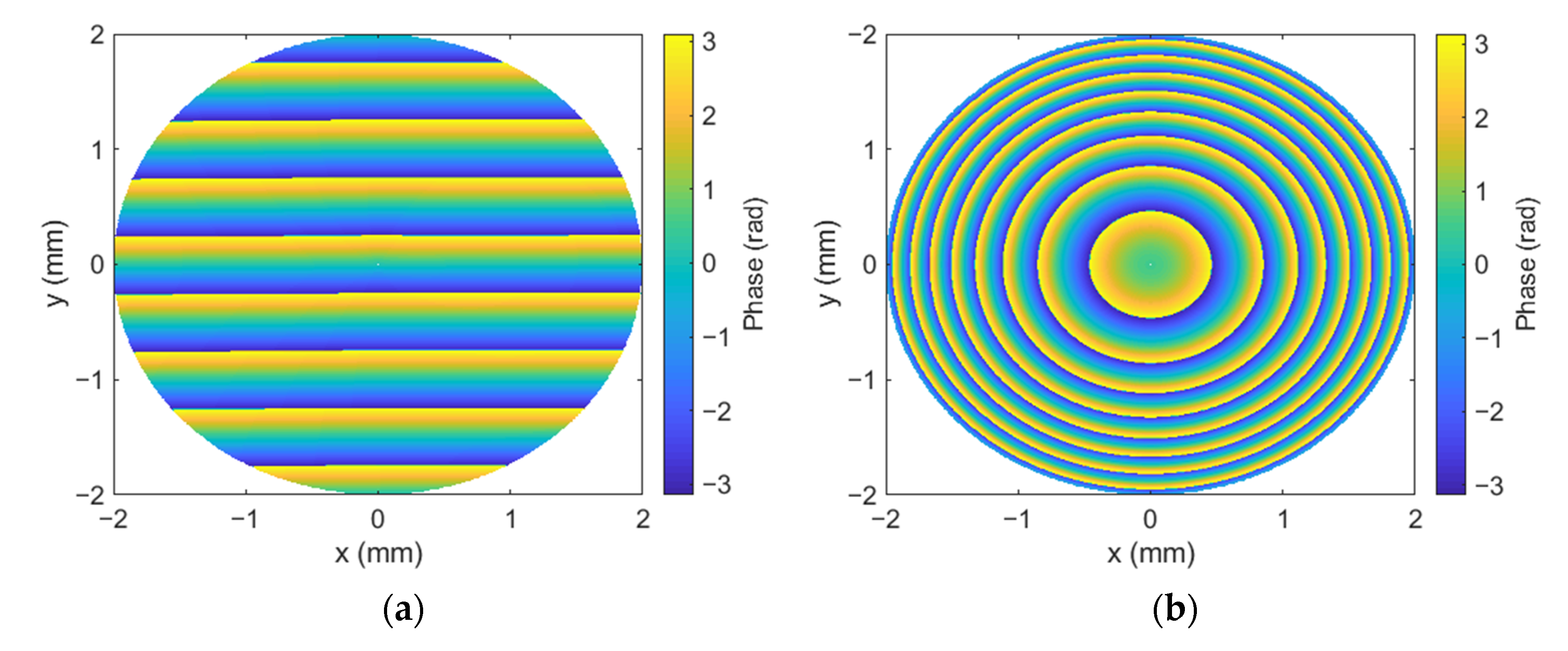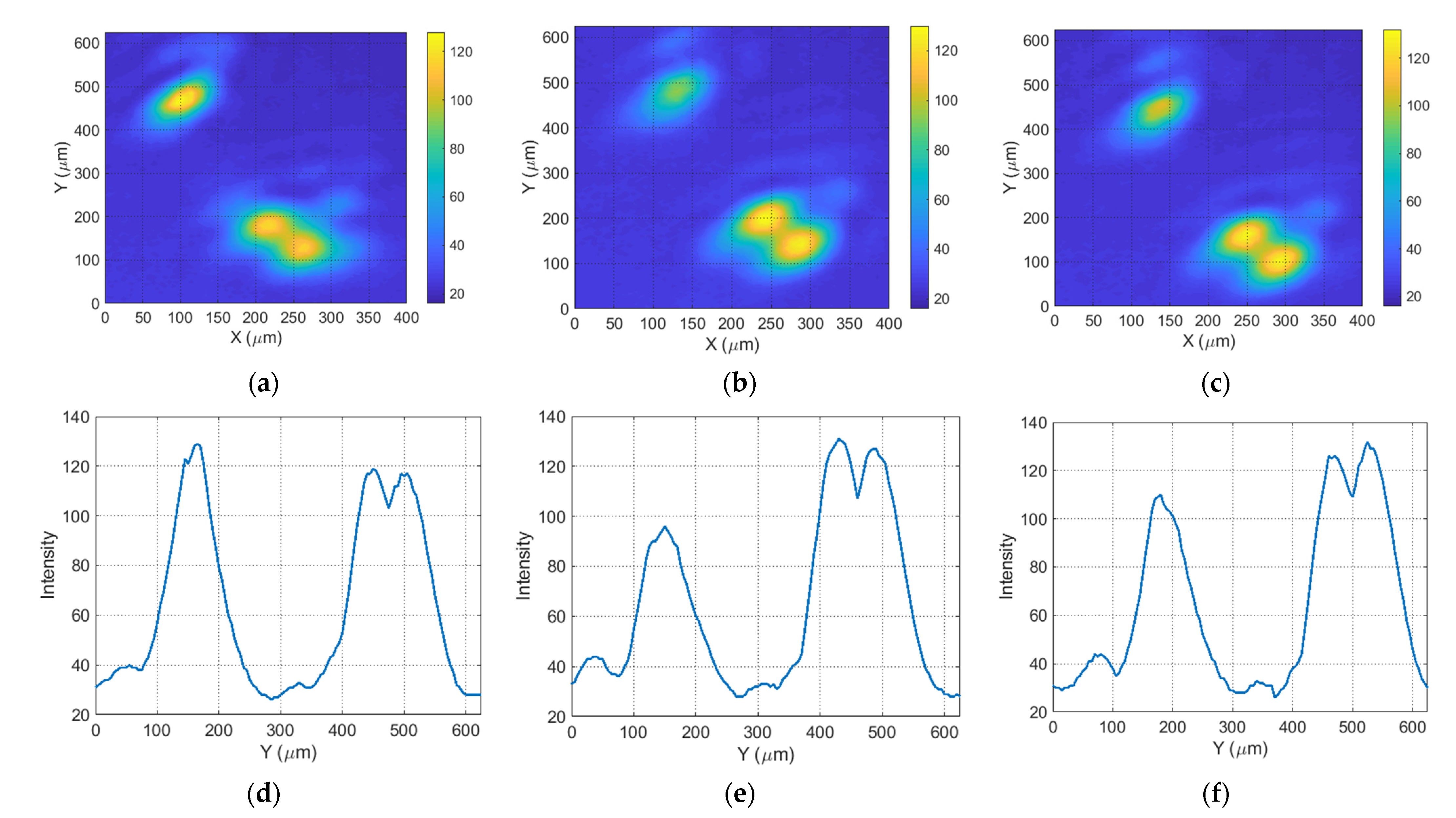Wavelength-Independent Correlation Detection of Aberrations Based on a Single Spatial Light Modulator
Abstract
1. Introduction
2. Materials and Methods
3. Experimental Demonstration
4. Results and Discussion
5. Conclusions
Author Contributions
Funding
Institutional Review Board Statement
Informed Consent Statement
Data Availability Statement
Acknowledgments
Conflicts of Interest
References
- Millán, M.S. Advanced optical correlation and digital methods for pattern matching—50th anniversary of Vander Lugt matched filter. J. Opt. 2012, 14, 103001. [Google Scholar] [CrossRef]
- Zlokazov, E.Y. Methods and algorithms for computer synthesis of holographic elements to obtain a complex impulse response of optical information processing systems based on modern spatial light modulators. Quantum Electron. 2020, 50, 643. [Google Scholar] [CrossRef]
- Zhang, Z.; You, Z.; Chu, D. Fundamentals of phase-only liquid crystal on silicon (LCOS) devices. Light Sci. Appl. 2014, 3, e213. [Google Scholar] [CrossRef]
- Pi, D.; Liu, J.; Wang, Y. Review of computer-generated hologram algorithms for color dynamic holographic three-dimensional display. Light Sci. Appl. 2022, 11, 231. [Google Scholar] [CrossRef] [PubMed]
- Yolalmaz, A.; Yüce, E. Comprehensive deep learning model for 3D color holography. Sci. Rep. 2022, 12, 2487. [Google Scholar] [CrossRef] [PubMed]
- Cheremkhin, P.A.; Krasnov, V.V.; Molodtsov, D.Y.; Rodin, V.G. Recognition of objects radiating with broad spectrum in dispersive holographic correlator. Opt. Commun. 2018, 421, 73–78. [Google Scholar] [CrossRef]
- Tao, W.; Ying-jie, Y.; Huadong, Z. Removal of magnification chromatism in optoelectronic full color holography. Opt. Precis. Eng. 2011, 19, 1414–1420. [Google Scholar]
- Yue, W.; Chuan, S.; Cheng, Z.; Kaifeng, L.; Sui, W. Research on color holographic display with space division multiplexing based on liquid crystal on silicon. Chin. J. Lasers 2012, 39, 1209001. [Google Scholar]
- Xiao, D.; Wang, D.; Liu, S.; Wang, Q. Color holographic system without undesirable light based on area sampling of digital lens. J. Soc. Inf. Disp. 2017, 25, 458–463. [Google Scholar] [CrossRef]
- Makowski, M.; Ducin, I.; Sypek, M.; Siemion, A.; Siemion, A.; Suszek, J.; Kolodziejczyk, A. Color image projection based on fourier holograms. Opt. Lett. 2010, 35, 1227–1229. [Google Scholar] [CrossRef]
- Makowski, M.; Ducin, I.; Kakarenko, K.; Suszek, J.; Sypek, M.; Kolodziejczyk, A. Simple holographic projection in color. Opt. Express 2012, 20, 25130–25136. [Google Scholar] [CrossRef] [PubMed]
- Ito, T.; Okano, K. Color electroholography by three colored reference lights simultaneously incident upon one hologram panel. Opt. Express 2004, 12, 4320–4325. [Google Scholar] [CrossRef] [PubMed]
- Makowski, M.; Sypek, M.; Ducin, I.; Fajst, A.; Siemion, A.; Suszek, J.; Kolodziejczyk, A. Experimental evaluation of a full-color compact lensless holographic display. Opt. Express 2009, 17, 20840–20846. [Google Scholar] [CrossRef] [PubMed]
- Esteve-Taboada, J.J.; Palmer, N.; Giannessini, J.C.; García, J.; Ferreira, C. Recognition of polychromatic three-dimensional objects. Appl. Opt. 2004, 43, 433–441. [Google Scholar] [CrossRef] [PubMed]
- Collados, M.V.; Arias, I.; Atencia, J.; Quintanilla, M. Anamorphic white light Fourier processor with holographic lenses. Appl. Opt. 2006, 45, 8706–8713. [Google Scholar] [CrossRef]
- Martinez, J.L.; Fernandez, E.J.; Prieto, P.M.; Artal, P. Chromatic aberration control with liquid crystal spatial phase modulators. Opt. Express 2017, 25, 9793–9801. [Google Scholar] [CrossRef]
- Zheng, H.; Zhou, C.; Shui, X.; Yu, Y. Computer-generated full-color phase-only hologram using a multiplane iterative algorithm with dynamic compensation. Appl. Opt. 2022, 61, B262–B270. [Google Scholar] [CrossRef]
- Martínez, J.L.; Martínez-García, A.; Moreno, I. Wavelength-compensated color Fourier diffractive optical elements using a ferroelectric liquid crystal on silicon display and a color-filter wheel. Appl. Opt. 2009, 48, 911–918. [Google Scholar] [CrossRef]
- Pérez-Tudela, J.; Juvelis, I.; Montes-Usategui, M.; Vallmitjana, S.; Carnicer, A. Reduction of the effect of aberrations in a joint-transform correlator. Appl. Opt. 2004, 43, 841–849. [Google Scholar] [CrossRef]
- García-Martínez, P.; Martínez, J.L.; Sánchez-López, M.M.; Moreno, I. Wavelength-compensated time-sequential multiplexed color joint transform correlator. Appl. Opt. 2010, 49, 4866–4873. [Google Scholar] [CrossRef]
- Ruchka, P.A.; Verenikina, N.M.; Gritsenko, I.V.; Zlokazov, E.Y.; Kovalev, M.S.; Krasin, G.K.; Odinokov, S.B.; Stsepuro, N.G. Hardware/Software Support for Correlation Detection in Holographic Wavefront Sensors. Opt. Spectrosc. 2019, 127, 618–624. [Google Scholar] [CrossRef]
- Krasin, G.; Kovalev, M.; Stsepuro, N.; Ruchka, P.; Odinokov, S. Lensless Scheme for Measuring Laser Aberrations Based on Computer-Generated Holograms. Sensors 2020, 20, 4310. [Google Scholar] [CrossRef]
- Kovalev, M.S.; Krasin, G.K.; Odinokov, S.B.; Solomashenko, A.B.; Zlokazov, E.Y. Measurement of wavefront curvature using computer-generated holograms. Opt. Express 2019, 27, 1563–1568. [Google Scholar] [CrossRef]
- Jolly, S.W.; Gobert, O.; Quéré, F. Spatio-temporal characterization of ultrashort laser beams: A tutorial. J. Opt. 2020, 22, 103501. [Google Scholar] [CrossRef]
- Goldberger, D.; Barolak, J.; Bevis, C.S.; Ivanic, B.; Schmidt, D.; Lei, Y.; Kazansky, P.; Mancini, G.F.; Durfee, C.G.; Adams, D.E. Single-pulse, reference-free, spatiospectral measurement of ultrashort pulse-beams. Optica 2022, 9, 894–902. [Google Scholar] [CrossRef]
- Neoričić, L.; Jusko, C.; Mikaelsson, S.; Guo, C.; Miranda, M.; Zhong, S.; Garmirian, F.; Major, B.; Brown, J.M.; Gaarde, M.B.; et al. 4D spatio-temporal electric field characterization of ultrashort light pulses undergoing filamentation. Opt. Express 2022, 30, 27938–27950. [Google Scholar] [CrossRef]
- Jeandet, A.; Jolly, S.W.; Borot, A.; Bussière, B.; Dumont, P.; Gautier, J.; Gobert, O.; Goddet, J.P.; Gonsalves, A.; Irman, A.; et al. Survey of spatio-temporal couplings throughout high-power ultrashort lasers. Opt. Express 2022, 30, 3262–3288. [Google Scholar] [CrossRef]
- Pichette, C.; Piché, M.; Marquet, P.; Thibault, S. Impact of wavefront aberrations on the duration of few-cycle laser pulses. J. Opt. Soc. Am. A Opt. Image Sci. Vis. 2022, 39, 259–266. [Google Scholar] [CrossRef]
- Primot, J. Theoretical description of Shack–Hartmann wave-front sensor. Opt. Commun. 2003, 222, 81–92. [Google Scholar] [CrossRef]
- Goodman, J.W. Introduction to Fourier Optics, 4th ed.; W.H. Freeman: New York, NY, USA, 2017. [Google Scholar]
- Lakshminarayanan, V.; Fleck, A. Zernike polynomials: A guide. J. Mod. Opt. 2011, 58, 545–561. [Google Scholar] [CrossRef]





| Methods | λ = 473 nm | λ = 532 nm | λ = 561 nm |
|---|---|---|---|
| WFS | 0.22λ | 0.45λ | 0.52λ |
| Proposed method | 0.23λ | 0.43λ | 0.5λ |
| Error | λ/100 | λ/50 | λ/50 |
Publisher’s Note: MDPI stays neutral with regard to jurisdictional claims in published maps and institutional affiliations. |
© 2022 by the authors. Licensee MDPI, Basel, Switzerland. This article is an open access article distributed under the terms and conditions of the Creative Commons Attribution (CC BY) license (https://creativecommons.org/licenses/by/4.0/).
Share and Cite
Stsepuro, N.; Kovalev, M.; Zlokazov, E.; Kudryashov, S. Wavelength-Independent Correlation Detection of Aberrations Based on a Single Spatial Light Modulator. Photonics 2022, 9, 909. https://doi.org/10.3390/photonics9120909
Stsepuro N, Kovalev M, Zlokazov E, Kudryashov S. Wavelength-Independent Correlation Detection of Aberrations Based on a Single Spatial Light Modulator. Photonics. 2022; 9(12):909. https://doi.org/10.3390/photonics9120909
Chicago/Turabian StyleStsepuro, Nikita, Michael Kovalev, Evgenii Zlokazov, and Sergey Kudryashov. 2022. "Wavelength-Independent Correlation Detection of Aberrations Based on a Single Spatial Light Modulator" Photonics 9, no. 12: 909. https://doi.org/10.3390/photonics9120909
APA StyleStsepuro, N., Kovalev, M., Zlokazov, E., & Kudryashov, S. (2022). Wavelength-Independent Correlation Detection of Aberrations Based on a Single Spatial Light Modulator. Photonics, 9(12), 909. https://doi.org/10.3390/photonics9120909






